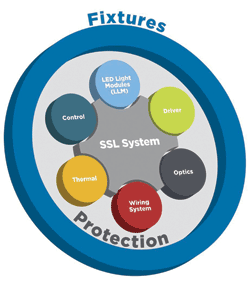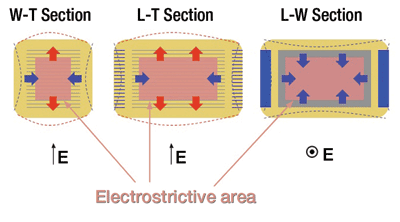A systems approach to solid-state lighting
BY ROB RIX, Vice President, Lighting, TE Connectivity
www.te.com
Complete solid-state lighting (SSL) solutions require technical expertise in myriad technologies — several distinct, high-level areas are easily identified (see Fig. 1). Knowledge in one area can be unique and the successful application of that know-how must be brought together at the systems level. Only in this way can an optimum lighting solution — one that takes into account the interaction between the technologies — be achieved.

It takes the multiple elements above to design a complete SSL system solution.
Why lifetime color consistency is important for LEDs
BY MICHAEL GODWIN, Director of Visible LEDs,
OSRAM Opto Semiconductors
www.osram-os.com
LEDs provide excellent color rendering and uniformity of light, and thereby achieve a high light quality for most lighting applications. LEDs also give designers a whole new palette of color, and, by enabling advanced digital control and the possibility of environmental sensing, deliver a multidimensional, interactive experience. With most all LED package options available for all colors, LEDs bring a whole new dimension of possibilities to lighting and design not possible with conventional fluorescent or incandescent lighting.

The fishbone diagram shows the factors that can affect color consistency over time.
Illuminating capacitor choices
BY NAOYUKI KOBAYASHI, Senior Product Manager, Murata Electronics,
www.murata.com
With a new focus on green technology and eco-friendly products, American households and companies are now familiar with light-emitting diodes (LEDs). The market for these products is extensive; practically any traditional method of lighting can be replaced with an LED.

The electrostrictive effect.
Throwing light on SSL testing
Increasing demand for high-quality, highbrightness LEDs for use in solid-state lighting (SSL) means that manufacturers have to be able to ramp up production while keeping tight control of device parameters. Since reliable and accurate electrical measurements are vital for the mass production of HB LEDs, it follows that a solid understanding of how to make suchmeasurements is critical.
Fortunately for those involved with SSL, Keithley Instruments is making available a treasure trove of information on how to perform such testing. They are offering a two-part on-line seminar by Applications Engineer David Wyban that examines the requirements for and challenges of testing HB LEDs, along with a technical article on LED fundamentals (“Accurate, Cost- Effective High Brightness LED Testing Starts with Device Fundamentals” by Mark Cejer, Marketing Director), two application notes (“High Speed Testing of High Brightness LEDs” and “Testing High Brightness LEDs under Pulse Width Modulation Using the Model 2651A High Power System SourceMeter Instrument”), and even an introductory YouTube video by Wyban (“How to Overcome Electrical Measurement Challenges of HighBrightness LEDs”).
What simplifies the testing of LEDs today is the fact that modern instruments like source/measure units are so much more capable than traditional instruments (for more on this development, see “Taking full advantage of modern bench instruments”, http://www2.electronicproducts.com/-article-farc_keithley_jul2011-html.aspx). By using SMUs, engineers can rapidly expand the test capabilities of a manufacturing line as demand dictates. SMUs let a single HB LED test system expand rapidly to test multiple devices.
If you’d like to get hold of this information, you can download it from the Web by going to http://gw1.vtrenz.net/?OIQ4NPSWG0:RAVYRL8AE3 and filling out a simple form. I think you’ll find it very useful.
Richard Comerford It takes the multiple elements above to design a complete SSL system solution. he fishbone diagram shows the factors that can affect color consistency over time. The electrostrictive effect.
For more on Project Lighting, visit www.electronicproducts.com/projectlighting
Advertisement
Learn more about Digi-Key





